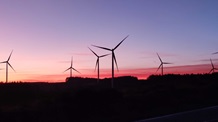Perspectives
The programmatic path to a greener future
Amidst a climate emergency, international tensions, rising prices and an imminent cost of living crisis, energy, and how we produce it, has never been higher on the agenda.
The challenge is becoming increasingly clear; the security of the UK’s energy supply must be addressed as a priority. However, in order to secure a future where the UK is more energy independent, a whole system approach must be taken by the sector to ensure that our network can deliver to increasing demand and carbon neutral aspirations.The UK Government recently set out prudent points around how the country can increase its electricity generation to meet growing demand, promoting a future which is based on low carbon and renewable energy, generated closer to home.
However, there is no point in generating all of this new clean energy if we can’t get it to where it is needed. Our existing energy networks are safe and reliable, but they were developed during a time where we had a limited number of large generators; a period during which we relied on coal and gas-fired power stations. Decades on, it is clear that our transmission and distribution network needs to quickly adapt to accommodate growing sources of decentralised energy generation, with vital infrastructure needed to bring increasing amounts of clean and green energy into our homes and businesses.
To meet growing demand, which is set to increase by approximately 50 percent by 2036, a more joined-up approach is required across the regulator, developers, system owners and operators. This will ensure that required infrastructure developments and upgrades can be made to cost and to programme.
Connecting to the network
A big challenge we face is processing the number of connections for new low carbon projects. Getting network outages to enable these connections is even more constrained while generation and demand are tighter, with pressure only increasing over time as impetus ramps up.
To address the backlog, Ofgem, NGESO and the Transmission Owners have begun a Transmission Entry Capacity amnesty; designed to remove stalled projects from the connections register and free up space for projects which are progressing more quickly.
This amnesty is a key enabler to planned revisions to the connections process, which will move away from a ‘first come, first served’ basis. The introduction of queue management arrangements will place greater responsibility on the developer to ensure that their projects progress on time. Or, more accurately, in line with the milestones they have committed to on their grid connection agreement.
A network-wide programme approach would do well to drive forward the principles of this, as it would provide greater transparency around delivery, informed through accurate and responsive reporting. This in turn would identify where blockers sit within the network, allowing for systems learning and the better allocation of resource and investment - ultimately delivering best value for the consumer.
Capacity
NGESO’s Network Option Assessment (NOA) provides recommendations around which network reinforcement projects should receive funding, and in what order. Although this helps inform how electricity can be evenly transmitted around the grid to where it is needed, it’s not a decision-making process.
What this process does give us however, is useful insight into the complicated and dynamic challenges the electricity network faces. However, the governance which sits behind this often struggles to remain live to the ever-evolving energy landscape, due to the robust justifications needed.
Therefore, by bringing a series of projects forward as part of a wider programme means that a more adaptive and responsive approach can be made towards how network infrastructure is upgraded. This ensures that delivery need can be prioritised in response to current system requirements, helping mitigate against the often-slow process of large infrastructure development.
Supply chain
Already, the supply chain is struggling to keep pace with the ever-growing pipeline of infrastructure projects and programmes. In the energy sector alone, as the UK pursues its sustainable goals, planned works surrounding new nuclear builds, small modular reactors, hydrogen, tidal, solar and wind will only increase the demand for the same things – key equipment and skilled people.
In the long term, this creates huge opportunities around developing new ‘green jobs’ within the energy sector. However, these skills will take some time to develop into a mature workforce.
To deliver in the shorter term, we will need to look to the bigger picture. By taking a wider approach and making the supply chain an active part of the solution, we can ensure that there is a clearer sense of that need and how to best optimise works to deliver more quickly on a better greener world.
Undoubtably, delivering on the UK’s low carbon energy future is a complex and long-term issue and one that will require an ever-evolving solution. But by creating a level playing field through bringing together all the various parts, there will be a clearer balance between investment in generation set against that made in transmission and distribution. The result? An efficient and responsive network which will propel the UK towards its green energy future.
I want a better perspective on












